Atlantis
Atlantis (Originalregel)
Game preparation
With /join 2-4 players can enter the game. With /start the game begins. Alternatively, you can use the game management use.
The game
Atlantis is a tactical game that is about bringing its poplars from the underlying island to the rescue mainland and collecting as many points as possible. As a result of the increasingly sinking path in the water, running becomes more and more expensive, so that it is necessary to use its cards skillfully in order to be able to travel as far as possible.
For players who already master the rules, there is also a short guide, where only the online service is explained.
Field
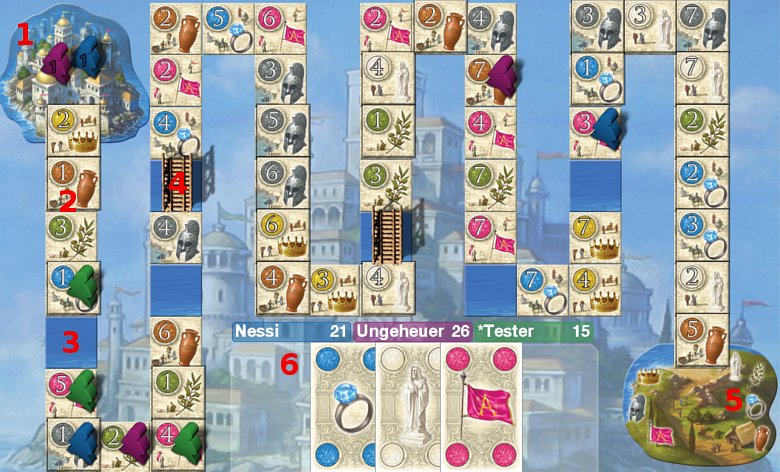
- Startfeld Atlantis
- Plots with values of 1-7
- Water gap
- Bridge
- Target field Mainland
- Player display
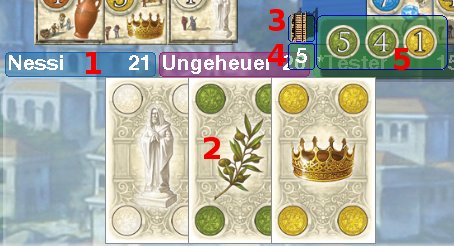
- Player name and current score
- Own handcards
- Bridge display (whether built or not)
- Handcards
- collected dot plates
Before the start of the game
At the beginning of the game, the route from Atlantis to the mainland (automatically) is designed. The following sequence applies: ten stacks of two, ten individual plates, six stacks of two, then a water gap and then six stacks of two, ten individual plates and ten stacks of two.
Each player receives three game characters and a bridge. The starter receives four motion cards, the following player five, etc.
Game sequence
Each player performs the following actions in succession:
- Figure moving
- How to take
- Track a motion map
Figure moving
A figure is moved by playing motion cards from the hand. According to the symbol or color of the card, the figure advances on the way to the next field with the same symbol or the same color. If the next field is occupied with this color, you have to play another card and jump to this color. In a field never several figures stand! With correspondingly many maps you can travel long distances in this way.
To move a figure, the active player must first select a figure he wants to move. To do this, you simply click on one of his characters. Then, for this figure, the possible goals that can be achieved with the aid of its motion maps are displayed.
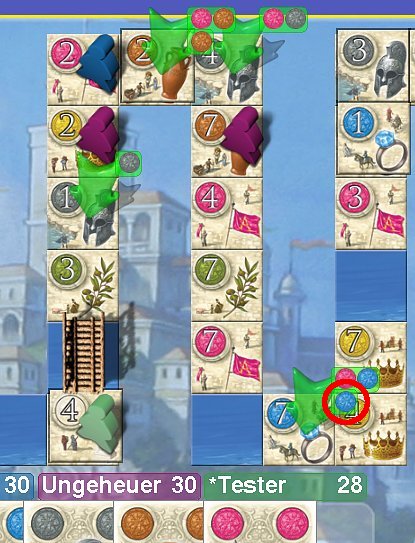
Example: Player Green has selected his figure at the bottom left. He's ever got a blue, gray, brown and pink hand map. The green arrows now show him what fields he could finish his train. On the right side of the green arrows it is indicated which maps it needs for this train. To draw on the gray one, for example, he only needs a gray map. To get to the gray four, it can first play the pink card. Since the pink two is occupied, it has to continue playing there and can play through the gray card to the next gray field, i.e. the gray four. To get to the brown two or the blue sevens, he has two options. It comes directly there with only one brown or blue card or, if it first plays the pink card, it also arrives with two cards. To select the desired destination, simply click on the corresponding color point next to the green arrow. So if green wanted to jump onto the blue screens with only one blue card, it would have to click the red-encircled point.
Water gaps
Being in Water gaps on the way, there are two ways to cross these:
- Building bridge
- Rent a boat
The cheapest way to cross a water gap is to Bridge to build the gap. However, each player only has exactly one bridge available. To build a bridge, click on the desired water field.

At the end of the building you click on the confirmation field.
A bridge also extends over several contiguous water fields. If an adjacent path plate is removed, the bridge is automatically extended accordingly. A built bridge is considered a free transition for All Players.
If you have no more bridge available or do not want to build yet, you can also use the water gaps Boat cross. This is not free, however. The price for a crossover depends on the path platelets adjacent to the water gaps. The smaller value is decisive and can be paid with collected platelets or hand cards. If you cross multiple gaps in one train, the number will be added and can be paid collected.
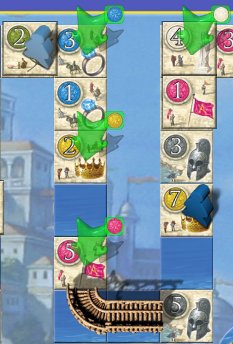
Example: Blue wants to jump to the white four here by playing a white card. He must cross three water gaps. The first gap is limited by a two and a five, so it must pay two points for it. The next gap is already covered by a bridge, so the transition is free. However, the third gap is flanked by a five and a seven and would therefore cost five points. For the complete train up to the white four blue should pay 2 + 5 = 7 points here.
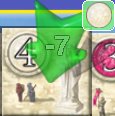
How much you have to pay for a path with water gaps is displayed when you drive with the mouse over the corresponding green target arrow.

If you have selected your train and clicked a color point, this window will open if you have to cross a water gap. In this way, it will be shown how much road tax is to be paid. It is possible to pay both with collected platelets and/or with hand cards (the color does not matter).
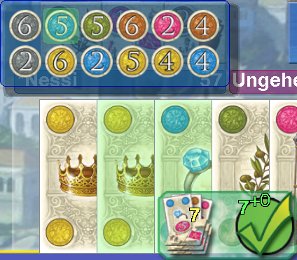
To do this, the mouse drives over its name and selects corresponding points and/or clicks on which of the hand cards. When you click the desired amount, you confirm with the green hook.
Attention: You can also overpay (constrained or inadvertently)! For example, if you only have to pay one, you only have higher points and no more hand cards, must: you are paying! Say, you have to give a higher-quality plate and give valuable points. If you don't pick up and re-elect, you should always make sure that the number of green checkers is displayed to avoid inadvertent overpayment.
Since the player has not collected a seven platelet here, he must mix: he chooses the blue five platelet and two of his handcards.

Special case: If a player with his handcards cannot make a valid train, he must take this round weeds. As compensation, he receives two handcards.
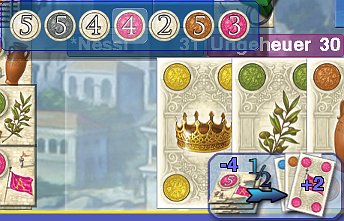
At the beginning of his train, a player can make a score Buy mobile cards. At the beginning of his train, he moves with the mouse over his name to call the point plates. Then it can select a plate and receives half of the value (with odd numbers rounded) in hand cards.
How to take
If the player has drawn a figure, he will then be allowed to take the next free path plate, which behind he's lying. If there is a water gap or bridge behind it, the next plate applies.
Move map
At the end of his train, the player moves a Move map. Once a figure has been drawn to the mainland, you can follow every train two With two figures on the mainland then always draw three cards.
Playing
The game ends immediately as soon as a player draws his third figure to the mainland. He gets four cards for it. The remaining characters of the other players are automatically pulled to the mainland. The points for possible water crossings are automatically deducted from the player's point account. The number of winning points is calculated from the value of the collected platelets plus the other hand maps (one point per card). The player with most points wins the game. At the same time, there are several winners.

